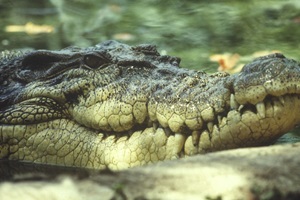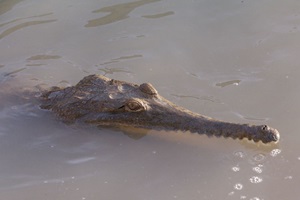This information was obtained from the Queensland Museum's Database on Reptiles and Amphibians of Queensland
Reptiles are scaly, ectothermic, egg-laying, vertebrates.
Crocodilia
Testudines

Saltwater Crocodiles
Identification:
The Saltwater or Estuarine Crocodile is a broad-snouted species that grows to a large size (up to 7 metres but rarely more than 5 metres). This is the largest of all living crocodiles.
Distribution:
Islands of the western Pacific, India, south-east Asia, New Guinea and northern Australia. In Queensland, Saltwater Crocodiles may be encountered in the sea or any coastal waterway north of Rockhampton. Individuals are occasionally seen as far south as the Mary River (Gympie).
Habitat:
Coastal rivers, swamps and lagoons – will readily enter the ocean.
Danger:
Dangerous. Due care should be taken when approaching the water or undertaking water-related actives within the known distribution of this species.
Crocodile warning signs are posted on many northern waterways and these should be heeded at all times.
Problem crocodiles should be reported to the
Department of Environment and Resource Management
, phone 1300 130 372.
Food:
A broad range of crustaceans, fish, reptiles, birds and mammals. Large crocodiles can overpower large mammals such as pigs, horses and cattle. Humans are also occasionally taken.
Breeding:
As many as 60 hard-shelled eggs are laid in a mound of vegetation and soil during the wet season. These take around three months to hatch and are guarded by the female throughout this time.
Sea turtles
The coastal waters of Queensland are important breeding and feeding habitat for marine turtles. Six of the world’s seven marine turtle species are known from Queensland. Leatherback Turtles are seasonal visitors arriving in the waters of south-eastern Queensland in the late winter months. The other species (Green Turtle, Loggerhead Turtle, Hawksbill Turtle, Flatback Turtle and Olive Ridley Turtle) have resident feeding and breeding populations in Queensland.
These turtles are long-lived and take 30 to 50 years to reach breeding age. They have complicated life histories and show high levels of fidelity to both breeding and feeding areas.
All marine turtles have strong, paddle-shaped flippers, nostrils positioned high on the snout and a bony shell. In all species, except the Leatherback and Flatback Turtles, the shell is covered in large plates. Marine turtles, unlike freshwater turtles, pull their heads directly back (cryptodirous).

Freshwater Crocodiles

Identification:
The freshwater crocodile is a narrow-snouted species that grows to 3 metres.
Distribution:
Far northern Australia. In Queensland, this species is usually found in western-flowing rivers that drain into the Gulf of Carpentaria. It also occurs in some eastern-flowing rivers on Cape York Peninsula where the headwaters are narrowly separated from western-flowing rivers.
Habitat:
Usually found in freshwater rivers and lagoons but will also enter brackish water.
Danger:
Inoffensive. Humans are occasionally bitten but such attacks are likely to be accidental, occurring in water with low visibility.
Food:
A broad range of crustaceans, fish reptiles, birds and small mammals.
Breeding:
Around 20 eggs are laid during the dry season in a hole dug into a sandbank.
For more information, please see the Queensland Department of Environment and Resource Management crocodile website .
Freshwater turtles
Freshwater turtles are commonly seen in most Queensland waterways. There are about 14 species (and a number of subspecies) recognised from Queensland, all belonging to the family Cheluidae.

There are two basic body forms, the short-necked turtles ( Elseya spp., Elusor macrurus , Emydura spp., Rheodytes leukops and Wollumbinia spp.) and the long-necked turtles ( Chelodina spp. and Macrochelodina spp.), which have extremely long, snake-like necks. Unlike the sea turtles and many foreign freshwater turtles, the Australian cheluids fold their necks side-ways under the protective edge of the shell (pleurodirous). They have clawed, webbed feet and most species have distinct barbels on the chin.
Most freshwater turtles leave the water to lay their eggs. One species, Macrochelodina rugosa , has developed an unusual nesting strategy. This turtle lays its eggs underwater, in a nest dug into the bottom of a shallow pool. The pool then recedes during the dry season until the nest is on land. The eggs delay development while submerged and laboratory tests have shown that even when they are submerged for 12 weeks they will still develop normally when removed from the water. The significance of this behaviour is not fully understood but it may prevent the eggs being eaten by terrestrial predators. By the time the nest is above the water level, the signs and odour of the nesting turtle will be largely gone.
In some of the short-neck turtles ( Rheodytes and Elusor ), the cloaca is lined with numerous finger-like projections that act in a similar manner to the gills of a fish. By drawing water into its cloacal cavity, the turtle can satisfy much of its oxygen needs. The turtles armed with this 'bum-breathing' system need surface only infrequently for air.
The Common Snake-necked Turtle ( Chelodina longicollis ) is often seen crossing roads during or after rain. This turtle is highly mobile and moves away from permanent water bodies to feed in seasonal lagoons that, for a time, offer a rich abundance of food. These turtles are often killed by traffic and there is evidence that they are declining in heavily settled areas. They were once common in Brisbane waterways but are now rarely seen.

